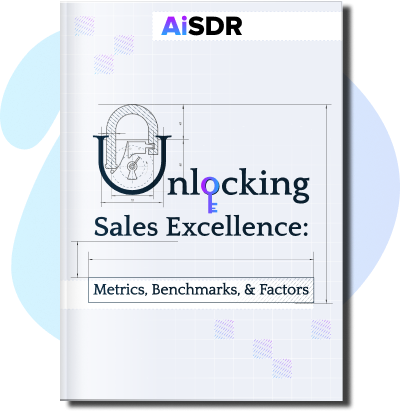Turn MQLs into SQLs: The Secret to Conversion Success with Inbound Prospecting

Find out how you can turn MQLs into SQLs through better inbound prospecting
Inbound prospecting is like fishing with the right bait—instead of chasing leads, you reel them in naturally. But how can you convert these small sales bites into bigger opportunities? By turning marketing-qualified leads (MQLs) into sales-qualified leads (SQLs) at a high rate. And with a little strategy, a few savvy tools, and some AI magic, you can make it happen.
What is inbound prospecting?
Inbound prospecting is a way of attracting potential customers by providing valuable content with solutions to their issues.
Instead of reaching out to cold leads, inbound prospecting pulls prospects in organically through content marketing, SEO, and social media. This is the big difference compared to outbound prospecting, where the sales team actively reaches out to potential leads through cold calls and emails, hoping to spark their interest.
Inbound prospecting aims to create an environment where customers seek you out. By sharing content that speaks to their needs, you warm up your leads, so when they do reach out, they are already primed to engage.
This approach has a few benefits:
- It’s customer-centric: Inbound prospecting prioritizes customer needs and shows how to satisfy them. This means that when a company attracts leads, they are more likely to convert into paying customers as they already see your product as a potential solution.
- It improves lead quality: When prospects actively seek out your content and engage with your brand, they tend to have a higher interest and intent.
- It’s cost-effective: Outbound prospecting requires a lot of time and money, with an average cold email response rate of just 7% and the need to send up to 306 emails to get a single B2B lead. Many prospects just aren’t interested or ready for your offer. But with inbound prospecting, you attract higher-quality leads who have already shown interest, leading to higher conversion rates and a stronger potential ROI.
How to set up inbound prospecting
Setting up inbound prospecting involves three crucial components: knowing your target audience, being creative with engaging content, and using the right tools to manage mundane tasks with minimal effort. Here’s what it means in practice.
Identifying your target audience
Start by creating an ideal customer profile (ICP) and buyer persona to clearly define who you’re targeting and offer content that speaks directly to your leads’ needs. For example, if you’re selling AI software for sales teams, your ICP might be a mid-sized SaaS company, while the buyer persona could be a tech-savvy sales manager.
Then segment your audience into smaller groups to personalize your messaging and make content even more relevant. (P.S. – Don’t short-change lead segmentation. In the future, you might be able to use these segments to simplify searches for lookalike audiences.)
Let’s say your tech-savvy sales managers represent two groups: those looking to boost their team’s efficiency and those wanting better data insights. You will need different messages for each group. Without segmenting, you might miss these important nuances.
Creating a content strategy that attracts leads
Once you understand your audience, you can imagine what content might work best for them and build a strategy around that. Start by selecting the main types of content—blog posts, social media posts, videos, or webinars—and decide how much of each you’ll produce. Then, think about the different kinds of content you’ll need, such as educational, entertaining, or informational, and figure out the right mix.
There are a million other details to consider when building a content strategy, so we won’t cover everything here. Let’s just recap the main conclusion: your content should address your audience’s pain points and offer solutions in a convenient and engaging way.
Deciding on lead magnets
Lead magnets are the bait that gets prospects to share their contact info with you in exchange for valuable content. These can be anything from reports, whitepapers, ebooks, checklists, or free courses that address the lead’s specific problem. Identify the lead’s issue that your free materials can help solve to get their interest and contact information in return.
Figuring out your inbound toolkit
To run inbound prospecting smoothly, you need the right tools to manage content, capture leads, and engage with prospects. They might include:
- CRM systems: All-in-one CRM platforms, like HubSpot, can automate and manage everything from content to email campaigns.
- Social media search tools: Platforms like LinkedIn Sales Navigator help you gather additional information to connect with prospects on LinkedIn without wasting hours on searching.
- Virtual SDRs: Platforms like AiSDR can recognize inbound lead intentions, streamline lead outreach, and automate follow-ups with potential customers without much effort from sales employees.
Using the right combo of these tools ensures that no prospects slip through the cracks while freeing up your team from mundane tasks.
Outlining lead qualification criteria
Once you start attracting leads, the next step is to determine if they’re ready for your marketing or sales efforts. To this end, you need to define criteria and score for each type of lead.
Marketing-qualified leads (MQLs) have shown interest in your content but aren’t ready to talk to sales just yet. These criteria might indicate MQLs:
- They downloaded an ebook but haven’t requested a demo
- They visit your website multiple times a month
- They actively interact with your content
You can add points to a lead’s score as the number of interactions grows.
Sales-qualified leads (SQLs) have taken actions suggesting they’re ready for direct sales contact, such as requesting a demo or signing up for a consultation. Leads in decision-making roles, like the VP of Sales or Director of IT, can be assigned higher scores because they have the authority to make purchasing decisions.
Qualifying your leads helps you understand what actions to take for successful prospecting, while scoring lets you prioritize leads based on their conversion likelihood. This way, you can allocate your attention and resources more efficiently, improving your MQL to SQL conversion rate.
But there’s more.
How to increase your MQL to SQL conversion rate
Converting MQL to SQL isn’t rocket science, but it does require attention to detail to get it right. Here’s how to boost your conversion rate.
Update lead scoring
Once you’ve set up your qualification and scoring model, make sure to keep it updated and effective. Lookalike modeling can help prioritize leads that resemble your best existing customers. For example, if you notice that leads from the healthcare industry or young startup founders tend to convert at higher rates, adjust your scoring to give those leads more weight.
Set up lead nurturing
It’s no news that nurturing is the key to moving MQL to SQL. The trick is to create a nurturing path and set up processes that work well for your leads without overburdening your employees. To this end, you’ll want to include a few crucial elements:
- Cadence: Find a rhythm that works for your audience, like starting with a weekly email and gradually increasing the frequency.
- Personalization: Use data to tailor your outreach. 72% of customers say personalized content significantly impacts their brand relationships and purchasing decisions.
- Content: Send nurturing content that directly addresses your lead’s pain points. This could include tips, guides, customer success stories, and actionable insights.
- Automation tools: By automating routine nurturing tasks like sending emails, you can give your employees more time to focus on new creative solutions.
Integrating AI into sales prospecting is one of the best ways to have all these elements covered.
AI for inbound prospecting
AI can supercharge your inbound prospecting by automating repetitive tasks far beyond what traditional CRM or marketing automation tools can do.
For example, AiSDR can identify four types of lead intents, qualify leads, and build nurturing campaigns tailored to their level of interest. Plus, it can pull data from an inbound lead’s LinkedIn profile to write highly personalized and relevant emails. As a result, you get 1-3 booked meetings per 100 leads—all without lifting a finger.
Still, to achieve meaningful results, you need to fine-tune your AI to maximize its effectiveness for inbound lead nurturing. Here’s what you can do.
- Identify your goals: Do you want AI to qualify leads faster? Personalize follow-ups? Automate initial outreach? Knowing your goal helps guide the AI’s role in the process.
- Collect data: Data that will fuel your AI’s decision-making include demographic information, engagement metrics (such as email opens and content downloads), and behavioral data (like common objections).
- Feed data into AI: Gradually input this data into your AI system. Use simple language and structure, clarify terms or jargon, and provide examples.
- Establish parameters for lead qualification: Clear parameters allow the AI to qualify leads as MQL or SQL. Ensure there are no contradictions, and consider adding subgroups for more specific instructions on the next step.
- Set priority for AI actions: Should AI respond to website queries first, send out initial emails second, and follow up third? Use the segmentation from the previous step and your scoring system to guide these priorities based on how hot a lead is.
- Provide content for AI to use: Integrate your AI tool with a knowledge base or content library so it has the resources it needs for personalized outreach.
- Set up data points for personalization: Determine key data points (like HubSpot properties) that AI will use to personalize interactions. This might include a lead’s name, industry, or specific pain points.
By taking these steps, you clearly instruct your AI on how exactly it should act to prospect and nurture leads. This approach can boost your MQL to SQL conversion rate and lead conversion without much effort from your marketing and sales managers.











